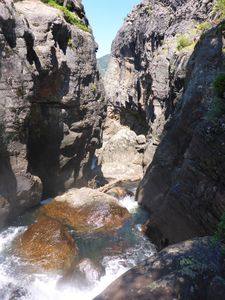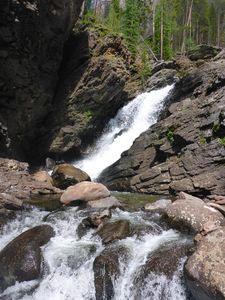Conditions:East Inlet (RMNP)-20160731155907
Latest: |
30 Jul 2016 (9 yrs, 4 mos ago) |
|---|
| Reported by: | Geomorphdan (18 reports) | |
|---|---|---|
| Quality: | Great |
|
| Waterflow: | Significant |
|
| Wetsuit: | Full wetsuit |
|
| Water temperature: | ||
| Difficulty: | Special challenges |
|
| Time:
"-9" is not declared as a valid unit of measurement for this property. |
Team: 2 people with experience level Advanced
Trip report URL:
Comments: Water Reference (estimation): More water than the banner photo (see our photo from a similar location below), but less than the photos in the Descent section.
We did this canyon on a warm, sunny day. The water wasn't low, but certainly wasn't as high as the photos above. See photos below of the narrows for water reference. We were able to down climb all rappels except for those in the narrows above the third falls without having to really leave the channel. We did rappel into the pool at the bottom of the second falls just for a fun swim, but that was largely unnecessary, and we were easily able to rig a retrievable anchor with only a 65m rope. We found 2-4mm wetsuits to be sufficient to stay comfortable. To enter the narrows (described as dangerous in the beta above), we rappelled off a small conifer on river right on the obvious ledge above the narrows. This tree now has a burnt red webbing sling with two rolled rap rings as an anchor. That rappel drops you on a rock and log that can be used the access the lower river right portion of the narrows, where some very fun low 5th class chimneying leads to a tunnel that comes out behind the third falls. The alcove behind the falls is a must see! Getting down from the alcove to the pool below was tricky at this water level. The falls had too much water to get into the jet, but anchors abound on the ledge to the river right of the alcove.
We first tried rappelling off one of three conifers into a small hole on the right side of the falls. You can stand in this hole at the pool water level and theoretically jump in the pool. However, you'd have to jump through the jet into a section of pool that may or may not have rocks (too hard to tell with the jet pounding the water). We decided that route was too risky at this water level and had to ascend out of the hole and back to the treed ledge. We then decided to rig an anchor around a horn/flake around 5 ft downstream and up from the three aforementioned trees at the end of the ledge. Getting an 8mm cord behind this flake took some considerable grass removal from behind the flake, rock rearranging, and a knot chock (took us a long time to rig this), but it ended up being a very solid anchor. The next party who comes down might want to add a better knot chock to back this up, but this anchor does allow a rappel just downstream of the main jet and into the pool. We felt that this was much safer than attempting to rappel in the jet at this water level. You drop into some considerable current pushing you against the right wall, so an aggressive swim is required to break the current and make it to the other side of the pool. At lower water, it may be safer to rappel off one of the trees and step into the water, then swim across. From here, it was more downclimbing around the other falls/cascades. We exited shortly after the last big falls and bushwhacked northeast up the hill and back to the trail. We left the trailhead around 7:30am and got back to our car around 4:45pm. However, we did spend at least an hour sunning ourselves at the top of the canyon, and spent over an hour trying to figure out the rappel around the third falls, and collected some data for a research project along the way. With the anchor now rigged as we left it, it may be quite a bit faster getting through this section. We both agreed that the narrows and the third falls make this canyon an absolute must-do in the Front Range.
All condition reports
| Date | Quality | Waterflow | Wetsuit | Difficulty | Time | Team | Reported by |
|---|---|---|---|---|---|---|---|
| Great | Significant | Full wetsuit | Special challenges | | 2 people Advanced | Geomorphdan (18 reports) | |
Comment: Water Reference (estimation): More water than the banner photo (see our photo from a similar location below), but less than the photos in the Descent section.
We did this canyon on a warm, sunny day. The water wasn't low, but certainly wasn't as high as the photos above. See photos below of the narrows for water reference. We were able to down climb all rappels except for those in the narrows above the third falls without having to really leave the channel. We did rappel into the pool at the bottom of the second falls just for a fun swim, but that was largely unnecessary, and we were easily able to rig a retrievable anchor with only a 65m rope. We found 2-4mm wetsuits to be sufficient to stay comfortable. To enter the narrows (described as dangerous in the beta above), we rappelled off a small conifer on river right on the obvious ledge above the narrows. This tree now has a burnt red webbing sling with two rolled rap rings as an anchor. That rappel drops you on a rock and log that can be used the access the lower river right portion of the narrows, where some very fun low 5th class chimneying leads to a tunnel that comes out behind the third falls. The alcove behind the falls is a must see! Getting down from the alcove to the pool below was tricky at this water level. The falls had too much water to get into the jet, but anchors abound on the ledge to the river right of the alcove. We first tried rappelling off one of three conifers into a small hole on the right side of the falls. You can stand in this hole at the pool water level and theoretically jump in the pool. However, you'd have to jump through the jet into a section of pool that may or may not have rocks (too hard to tell with the jet pounding the water). We decided that route was too risky at this water level and had to ascend out of the hole and back to the treed ledge. We then decided to rig an anchor around a horn/flake around 5 ft downstream and up from the three aforementioned trees at the end of the ledge. Getting an 8mm cord behind this flake took some considerable grass removal from behind the flake, rock rearranging, and a knot chock (took us a long time to rig this), but it ended up being a very solid anchor. The next party who comes down might want to add a better knot chock to back this up, but this anchor does allow a rappel just downstream of the main jet and into the pool. We felt that this was much safer than attempting to rappel in the jet at this water level. You drop into some considerable current pushing you against the right wall, so an aggressive swim is required to break the current and make it to the other side of the pool. At lower water, it may be safer to rappel off one of the trees and step into the water, then swim across. From here, it was more downclimbing around the other falls/cascades. We exited shortly after the last big falls and bushwhacked northeast up the hill and back to the trail. We left the trailhead around 7:30am and got back to our car around 4:45pm. However, we did spend at least an hour sunning ourselves at the top of the canyon, and spent over an hour trying to figure out the rappel around the third falls, and collected some data for a research project along the way. With the anchor now rigged as we left it, it may be quite a bit faster getting through this section. We both agreed that the narrows and the third falls make this canyon an absolute must-do in the Front Range. | |||||||






